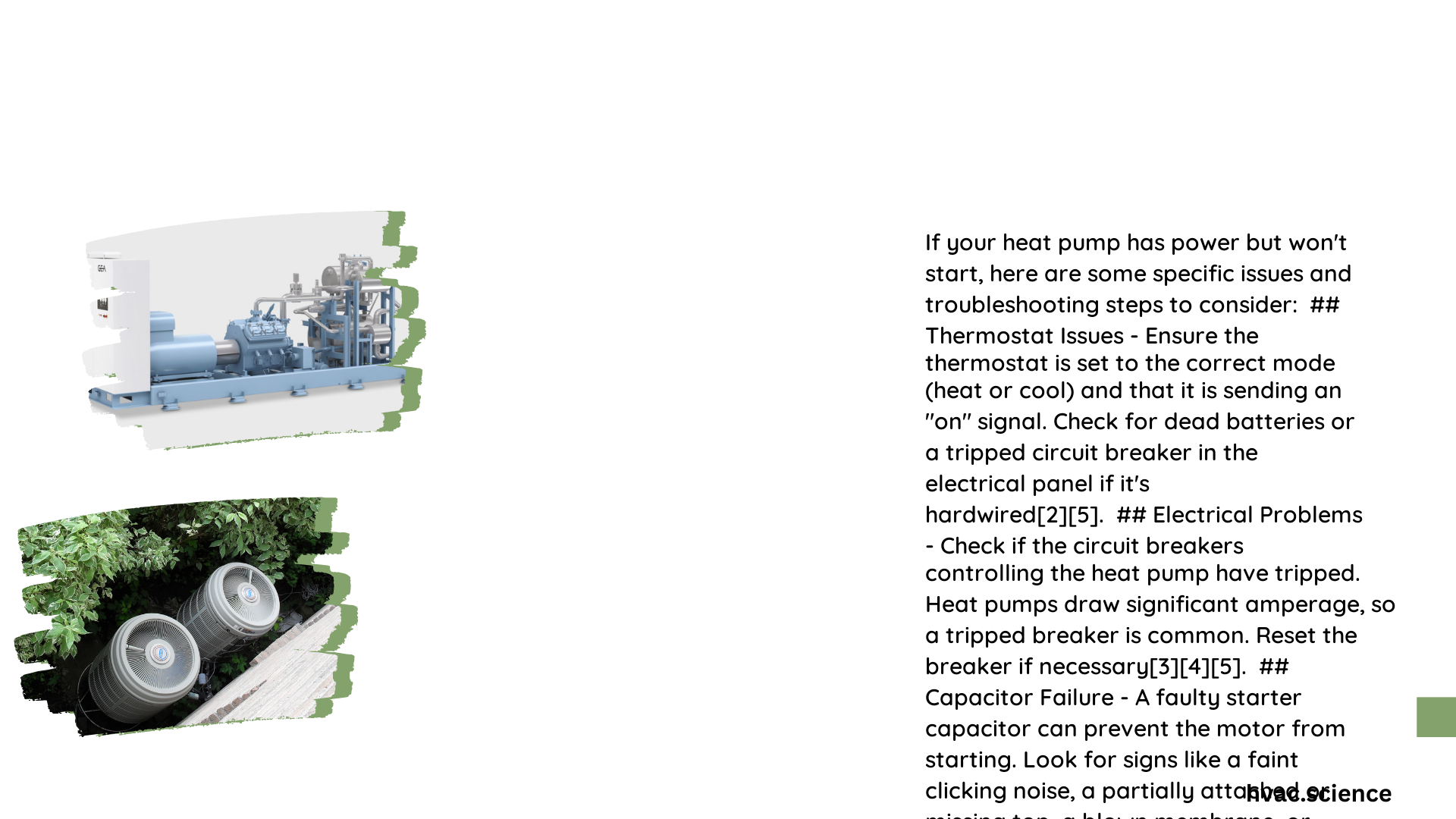A heat pump that has power but won’t start can be frustrating and concerning for homeowners. This issue often stems from electrical problems, component failures, or environmental factors. Common causes include thermostat malfunctions, tripped circuit breakers, faulty contactors or capacitors, and refrigerant leaks. Proper diagnosis and timely repairs are crucial to restore your heat pump’s functionality and maintain your home’s comfort.
Why Does My Heat Pump Have Power But Won’t Start?
When your heat pump has power but refuses to start, several factors could be at play. Let’s explore the most common reasons and their solutions:
What Electrical Issues Can Prevent a Heat Pump from Starting?
Electrical problems are often the culprit when a heat pump won’t start despite having power. Here are some specific areas to check:
- Voltage and Amperage:
- Ensure the voltage supply matches your heat pump’s specifications (typically 240V for residential units).
-
Check the amperage draw against the rated capacity of the circuit breaker.
-
Power Switches and Circuit Breakers:
- Verify that power switches for both indoor and outdoor units are in the ‘ON’ position.
-
Inspect the circuit breaker panel for any tripped breakers and reset if necessary.
-
Thermostat Issues:
- Check if the thermostat has power and is set correctly.
- For battery-powered thermostats, replace batteries if needed.
- Ensure the thermostat is properly calibrated.
What Component Failures Can Cause a Heat Pump to Not Start?
Several key components can fail and prevent your heat pump from starting:
- Contactor Problems:
- The contactor connects and disconnects power to the compressor and fan motor.
- A faulty contactor may not engage, preventing the heat pump from starting.
-
Listen for a clicking sound when the thermostat calls for heating or cooling.
-
Capacitor Issues:
- The starter capacitor provides the initial energy boost to start the compressor and fan motor.
-
A broken capacitor may result in a clicking noise from the condenser without the motor starting.
-
Refrigerant Leaks:
- Low refrigerant levels due to leaks can prevent the heat pump from starting.
- This requires professional diagnosis and repair.
How Can Environmental Factors Affect Heat Pump Startup?
Environmental conditions can sometimes interfere with your heat pump’s operation:
- Extreme Temperatures:
-
Very high or low temperatures can strain the system and prevent startup.
-
Snow and Ice:
-
Accumulation on the outdoor unit can block airflow and hinder operation.
-
Debris:
- Leaves, twigs, or other debris around the outdoor unit can obstruct proper functioning.
What Are the Steps to Troubleshoot a Heat Pump That Won’t Start?
Follow these steps to diagnose the issue:
- Check the thermostat settings and power.
- Inspect circuit breakers and power switches.
- Listen for unusual noises (clicking without startup).
- Examine the outdoor unit for obstructions or damage.
- Check air filters and registers for blockages.
- If these steps don’t resolve the issue, call a professional.
What Are the Potential Costs and Timeframes for Heat Pump Repairs?
Repair costs and timeframes can vary widely depending on the specific issue:
| Repair Type | Estimated Cost | Estimated Timeframe |
|---|---|---|
| Thermostat replacement | $50-$200 | 1-2 hours |
| Capacitor replacement | $50-$150 | 1-2 hours |
| Contactor replacement | $50-$150 | 1-2 hours |
| Refrigerant recharge | $50-$200 | 2-4 hours |
| New heat pump installation | $1,000-$5,000+ | 1 day or more |
Labor costs typically range from $75-$150 for a service call, plus $100-$300 per hour for repairs.
When Should I Call a Professional for My Heat Pump Issues?
While some troubleshooting steps can be performed by homeowners, certain situations require professional intervention:
- Electrical issues beyond resetting a circuit breaker
- Suspected refrigerant leaks
- Unusual noises or smells from the unit
- Repeated system failures
- Any repairs involving internal components
Remember, attempting complex repairs without proper knowledge and tools can be dangerous and may void your warranty.
By understanding these common issues and their solutions, you can better diagnose and address problems when your heat pump has power but won’t start. Regular maintenance and prompt attention to issues can help prevent more serious and costly repairs in the future.
References:
1. CieloWigle – Heat Pump Troubleshooting
2. Estes Services – Troubleshooting Heat Pumps
3. The Furnace Outlet – Heat Pump Troubleshooting

